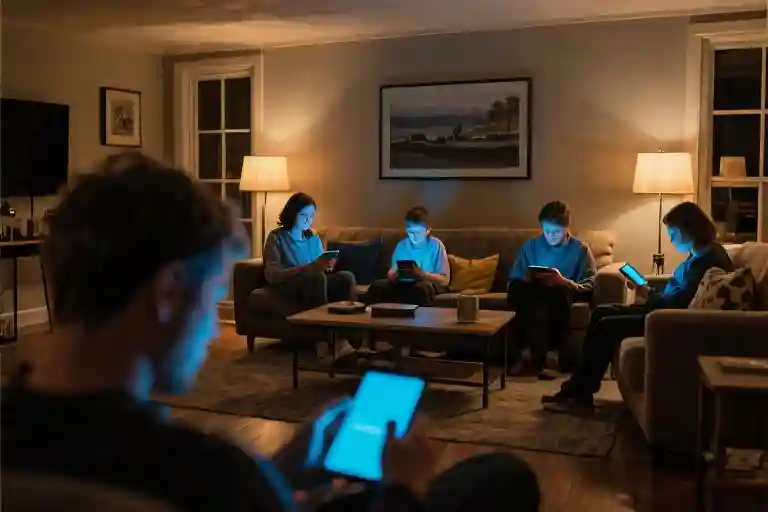The first thing I remember about my grandmother’s house was the noise – not the harsh pings of notifications, but the warm hum of overlapping conversations. There were always neighbors dropping by unannounced, children tracking mud across the kitchen floor after playing outside, and the rhythmic clatter of mahjong tiles from the corner where the elders held court. These memories surface unexpectedly now when I walk through silent office corridors where colleagues message each other from adjacent cubicles, or pass playgrounds where children sit together yet apart, each absorbed in their own glowing rectangle.
This isn’t another rant against technology. My phone sits within arm’s reach as I write this, its screen still warm from checking the weather. The contradiction gnaws at me – the same devices that connect me to childhood friends across continents also isolate me from the person sitting across the table. We’ve gained the world through our screens, but at what cost to the texture of our daily lives?
Research from the University of Pennsylvania confirms what many of us feel in our bones: despite being more ‘connected’ than any generation in history, nearly half of Americans report frequent loneliness. The very tools designed to bridge distances have somehow erected invisible walls between us. I notice it in small moments – when a group of teenagers at the cafe communicate through shared TikTok videos rather than conversation, or when my own hand instinctively reaches for my phone during those rare lulls in conversation.
Yet the problem isn’t technology itself, but our relationship with it. Those childhood memories weren’t technology-free – they included landline phones ringing in the background, televisions broadcasting evening news, cassette players spinning lullabies. The difference was that these tools served as punctuation marks in our human interactions, not the entire sentence. Somewhere along the way, we’ve allowed the balance to shift until our devices stopped being tools and started being habitats.
The quiet tragedy unfolds in mundane moments: family dinners where screens glow brighter than eye contact, workplaces where Slack messages replace hallway conversations, classrooms where students can summarize articles flawlessly but struggle to sustain a nuanced debate. We’ve outsourced our memory to cloud storage, our sense of direction to GPS, our curiosity to search engines – and in the process, we may be losing something essential about being human.
This isn’t about nostalgia for some imagined golden age. The past had its own isolation and loneliness. But as we stand at this peculiar crossroads of technological abundance and emotional scarcity, it’s worth asking: when we designed these miraculous tools to connect us, why do so many of us feel more alone than ever?
The Reshaped Landscape of Digital Living
The kitchen table conversations that used to stretch for hours now compete with notification pings. Where we once leaned in to catch every word of a friend’s story, we now scroll through abbreviated versions of their lives on glowing rectangles. This isn’t just about technology replacing old habits—it’s about how our very spaces for human connection have been quietly reconfigured.
The Transformation of Social Bonds
Remember when catching up required actual catching—running into someone at the grocery store or making plans days in advance? Social interactions have condensed into efficient bursts: emoji reactions standing in for laughter, heart icons substituting for hugs. The irony stings—we’ve never been more connected technologically, yet genuine understanding seems harder to reach. Studies show the average person checks their phone 58 times daily, with 30% of those checks lasting less than 30 seconds. This constant partial attention creates what psychologists call ‘continuous co-presence’—physically together but mentally elsewhere.
Family dinners illustrate this shift most painfully. The modern dining table often hosts what I’ve come to call ‘the silent symphony’—the clinking of cutlery accompanied by the tap-tap of thumbs on glass. Research from the University of Michigan reveals families who keep phones away during meals report 37% higher satisfaction with their relationships. Yet the gravitational pull of devices proves stronger than these statistics for many households.
The Empty Nest 2.0
Homes have become strange hybrids of connection and isolation. Smart speakers answer our questions before we can ask another human, while entertainment systems tailor content to individual preferences in separate rooms. The living room—once the communal heart of a home—now frequently serves as a physical Wi-Fi hotspot where family members coexist in parallel digital universes.
A neighbor recently confessed she tracks her teenagers’ wellbeing through Spotify playlists rather than face-to-face conversations. ‘If his playlist gets angsty, I know to text him about school stress,’ she explained. This indirect parenting reflects our growing discomfort with unmediated interaction. The American Psychological Association reports 42% of parents feel less confident in reading their children’s emotional states compared to pre-smartphone eras.
The Erosion of Cognitive Labor
Workplaces showcase perhaps the most concerning transformation—not just in how we complete tasks, but in whether we truly engage with them at all. The rise of AI writing assistants has created what tech ethicists term ‘thinking outsourcing.’ Why wrestle with structuring a report when Claude can draft it in seconds? What’s the value of developing original ideas when GPT can generate ten alternatives before our coffee cools?
This dependency carries hidden costs. Neuroscientists at Stanford found that professionals who frequently use AI writing tools show decreased activity in the dorsolateral prefrontal cortex—the brain region responsible for complex reasoning and originality. Like muscles atrophy without use, our cognitive capacities may weaken when constantly assisted. The very tools meant to enhance productivity could be diminishing our ability to produce meaningful thought.
Yet this isn’t inevitable destiny. Between these paragraphs, I caught myself reflexively reaching for my phone to check notifications. The impulse lasted only seconds before I recognized it—that’s the first step toward change. Awareness of how profoundly our living spaces, relationships, and very minds have been reshaped creates possibility. The contours of our digital landscape aren’t fixed; we retain the power to redraw them with intention.
The Hidden Costs of Our Digital Dependence
We’ve all been there—scrolling mindlessly through social media feeds at midnight, telling ourselves ‘just five more minutes’ as our thumbs swipe endlessly upward. This isn’t simply a bad habit; it’s by design. The same technology that promised to connect us has quietly rewired our brains’ reward systems, creating patterns of dependency more subtle than caffeine and more pervasive than nicotine.
How Attention Economy Hijacks Your Brain
Every notification ping, every ‘like’ animation, every infinite scroll interface operates on the same principle: intermittent variable rewards. Psychologists recognize this as the most powerful reinforcement schedule—the same mechanism that keeps gamblers pulling slot machine levers. Our dopamine receptors light up not because the content is inherently valuable, but because we might discover something novel. Tech companies employ teams of neuroscientists to optimize these micro-interactions, turning casual usage into compulsive checking.
A 2023 Cambridge study found the average person now experiences 150+ micro-moments of decision fatigue daily from digital interruptions. We’ve outsourced our attention spans to algorithms that profit from our distraction. The cruel irony? These tools designed to save time now consume more of it than any household chore or commute ever did.
Living Inside Algorithmic Bubbles
Recommendation engines don’t just reflect our preferences—they actively shape them. When platforms feed us increasingly narrow content based on past clicks, they create what sociologists call ‘cognitive ghettos.’ Your political views, musical tastes, even humor become trapped in feedback loops where difference disappears. This explains why family dinners now feature bewildering arguments where everyone cites ‘what the internet says’ yet references entirely different realities.
Researchers at Stanford recently demonstrated this by tracking two groups’ YouTube recommendations after watching identical climate change videos. Within three clicks, one group received climate denial content while the other got environmental activism—based solely on their browsing histories. We’re no longer passive consumers but unwitting participants in massive behavioral experiments.
The Empathy Deficit
Perhaps the most disturbing cost emerges in our capacity for human connection. MRI scans reveal that excessive screen time literally shrinks gray matter in brain regions responsible for emotional regulation. That 19% decline in empathy metrics isn’t just a statistic—it manifests when teens photograph homeless people instead of offering help, or when coworkers send Slack messages to someone three desks away.
But here’s what the data doesn’t capture: the slow erosion of those unquantifiable moments that make us human. The shared silence between old friends that no longer feels comfortable. The lost art of reading facial cues during difficult conversations. The way children now interrupt stories to tap imaginary ‘skip ad’ buttons in real life.
This isn’t about rejecting technology—I’m typing these words on a laptop while my smartwatch tracks my stress levels. It’s about recognizing that every tool comes with tradeoffs, and we’ve been trading away pieces of our humanity without keeping proper accounting. The bill always comes due, usually when we least expect it: during a child’s recital we watch through a phone screen, or at a hospital bedside when we realize no algorithm can teach us how to simply be present.
Reclaiming Human Connections in a Digital Age
We’ve all experienced it – that moment when you realize everyone at the dinner table is silently scrolling through their phones instead of talking. The glow of screens has replaced the warmth of eye contact, and emojis stand in for genuine laughter. This isn’t about rejecting technology outright (my own phone sits within arm’s reach as I write this), but about consciously creating spaces where human interaction can flourish.
Creating Tech-Free Zones
The bedroom might be the most logical place to start. When we charge our phones across the room instead of under our pillows, we reclaim those precious first and last moments of the day. There’s something profoundly human about waking up to sunlight rather than notifications, about letting our first thoughts form organically instead of being hijacked by overnight emails. These small spaces become sanctuaries where our brains can remember how to be bored, how to daydream, how to simply exist without digital input.
The Art of Focused Conversation
The ‘Pomodoro Communication’ method adapts the famous productivity technique to human connection. Setting aside 25 minutes for uninterrupted conversation feels almost radical in our age of perpetual multitasking. During these sessions, phones go in another room, laptops stay closed, and the only notifications we heed are the subtle ones from each other’s facial expressions. It’s astonishing how conversations deepen when we’re not constantly glancing at screens, how much more we hear when we’re truly listening.
Rediscovering Analog Thinking
There’s magic in putting pen to paper that typing can’t replicate. The physical act of writing slows our thoughts just enough to let them develop more fully. Keeping a notebook by the bed, in the kitchen, or in your work bag creates opportunities for reflection that don’t involve screens. These handwritten notes become something more personal than digital files – they carry the weight of our actual hand movements, the occasional coffee stain, the evidence of our human imperfections.
What makes these practices powerful isn’t their complexity, but their simplicity. They don’t require expensive gadgets or complicated systems – just a bit of intention. The spaces we create, the conversations we protect, the analog moments we preserve – these become the brushstrokes that add color back into our increasingly monochrome digital lives. They remind us that beneath all the technology, we’re still creatures who need eye contact, who thrive on shared silence as much as shared words, who require spaces where our humanity isn’t mediated through screens.
When Machines Simulate Emotion: What Remains Real?
The glow of screens has become our campfire. We huddle around digital devices the way ancient tribes gathered around flames, except our modern circles often consist of solitary figures bathed in blue light. That quiet moment when you pause mid-scroll, wondering why a room full of online connections still feels hollow—that’s the fracture point where we must begin.
Artificial intelligence now crafts poems that scan perfectly, generates condolence messages with appropriate empathy markers, and even proposes marriage with algorithmic precision. The machinery of connection hums along beautifully, yet something essential slips through its meticulously designed fingers. We’ve created systems that mimic human interaction so well they’ve begun to replace the real thing, like plastic fruit in a bowl—visually convincing but devoid of scent, texture, or the occasional bruise that makes things genuine.
Three troubling patterns emerge when machines handle our emotional labor:
- The delegation dilemma: Asking ChatGPT to ‘sound more caring’ in an email to a grieving friend saves time but amputates the messy, imperfect process by which we translate feelings into words—a process that’s therapeutic in itself.
- The authenticity paradox: AI-generated birthday wishes often outshine our own fumbling attempts, making us increasingly reluctant to risk inadequate self-expression. Why write a mediocre poem when the bot can produce Shakespearean sonnets?
- The emotional outsourcing effect: Studies at Stanford’s Human-Centered AI Institute found that people who regularly use emotional AI tools show decreased confidence in their own ability to provide comfort, creating a vicious cycle of dependence.
Yet for all their sophistication, these systems lack what neurologist Antonio Damasio calls ‘somatic markers’—the physical sensations that accompany real human connection. No algorithm can replicate the way a friend’s voice catches when sharing vulnerable news, or the particular warmth of a handwritten note where you can see where the pen pressed harder during emotional moments.
This isn’t about rejecting technological progress. The same apps that isolate can also connect—when used intentionally. That grandmother in Milan seeing her grandchild’s first steps via video call experiences real joy. The difference lies in whether we use tools to augment human connection or substitute for it entirely.
A modest proposal: Next time you need to express something important, try this three-step resistance:
- First draft by hand: Let the ink smudges and crossed-out words stand as evidence of your human struggle to articulate care.
- Wait one sleep cycle: Emotions integrate differently after rest. What you want to say at midnight often differs from morning clarity.
- Deliver with presence: If possible, share the message face-to-face. Notice the micro-expressions no camera can fully capture.
We’re entering an era where the premium won’t be on flawless execution but on imperfect authenticity. The scars where we’ve rubbed against real life—the pauses, the slightly off-key laughter, the handwritten notes with coffee stains—these will become the new status symbols. Because when machines master the art of pretending to care, genuine human attention becomes the rarest commodity.
The question isn’t whether AI can simulate love, but whether we’ll still know how to recognize the real thing when it’s offered. That uncertainty alone should give us pause before we outsource another piece of our humanity to the waiting algorithms.





